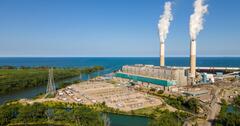

 By Jason Hayes
By Jason Hayes
Michigan is unique in many ways, perhaps most noticeably in its geography and relationship with the Great Lakes. Despite this, the state’s elected officials are considering energy policies copied and pasted from California and Texas and countries across Europe. These will impose the same harmful effects that have damaged access to reliable and affordable energy in those places.
The Michigan Legislature appears ready to pass a string of bills that lawmakers promise will go a long way to achieving the goals set forth in Gov. Gretchen Whitmer’s MI Healthy Climate Plan. That proposal, among other things, aims to achieve net-zero greenhouse gas emissions in Michigan by 2050.
Across the nation, people are increasingly aware of and concerned about these “energy transition” plans. A July poll published by Morning Consult for the Electric Power Supply Association found that “approximately half of the 2,205 respondents say their reliability unease has grown since last year, and three in four are afraid their bills will increase in the months ahead.” Nearly 70% said they are worried about closing power plants without sufficient replacement.
These concerns are valid. Modeling completed by the Center of the American Experiment for a soon-to-be-released Mackinac Center report demonstrates that meeting net-zero energy production mandates with wind, solar and battery backup will cause Michigan’s electricity prices to skyrocket. As of Nov. 1, the Michigan House version of the net-zero mandates (HB 4759) would cost Michiganders an astounding $386 billion through 2050 — an average annual additional cost of $2,746 per customer.
Michiganders already pay the highest electricity rates in any of the Great Lakes states and suffer through some of the worst electric service reliability in the nation. The intermittent nature of solar and wind will further endanger reliable electric services. The modeling projects that a wind, solar and battery-based grid would leave Michiganders exposed to blackouts lasting as long as 61 hours during peak demands for electricity.
In recent testimony to the Michigan Senate Energy and Environment Committee, the Mackinac Center recounted warnings about grid instability from several industry experts. We quoted admonitions from utility executives, two Federal Energy Regulatory Commissioners, the Acting Chairman of FERC, the CEO of the National Electric Reliability Corporation, a reliability assessment from the National Electric Reliability Corp., a report on the energy transition prepared by PJM, and numerous warnings from the Midcontinent Independent System Operator. Each quote warns of the growing risk posed by rushed closures of reliable generation facilities paired with attempts to replace them with unreliable and intermittent energy sources like wind and solar.
Our model also investigates a second method of meeting CO2 emissions reduction goals — deemed the Lower Cost Decarbonization Scenario, or LCD. This alternate option retains the state’s existing large coal and natural gas facilities but retrofits them with carbon capture and storage technology. While these plants continue to operate, the scenario details the costs of building new nuclear facilities — small modular reactors and larger APR-1400s — to eventually replace the existing coal and natural gas plants. Using coal and natural gas with carbon capture, as well as new nuclear, the second scenario achieves state officials’ desired CO2 reductions but saves the ratepaying public $180 billion through 2050. This second option also avoids the potential for extended and dangerous blackouts.
To be clear, there is no inexpensive way to meet the governor’s CO2 emission reduction targets. Both scenarios add substantial costs to Michigan’s electricity future. Despite the high cost and potential impacts on reliability, Whitmer and the Michigan Legislature have committed to a wind, solar and battery-heavy plan that will hike prices and hollow out the state’s electric grid, leaving Michigan residents exposed to extended blackouts and increased restrictions on electric services.
Adding insult to injury, the wind, solar and battery option will have no perceptible impact on climate or world temperatures. The Senate and House bill packages would avert just one one-thousandth of a degree Celsius of warming by the year 2100, based on the same models that underlie the Obama administration’s Clean Power Plan. That is a temperature reduction too small even to be reliably measured. A recent report by the Citizens Research Council of Michigan agreed, noting that “it is not possible for Michigan to measurably mitigate climate change through state-level emissions-reduction policies.”
Erratic power generation drives away businesses and endangers the residents of the state, especially during the heat of summer and cold of winter. But attempting to impose California-style energy policies on the state of Michigan will yield the same spiking prices and unreliable service that California residents endure.
If the state is unwilling to stop the rush to net zero, legislators should pursue the second, lower-cost decarbonization approach. The LCD approach is a far more reasonable and prudent means of encouraging reliable and affordable electricity generation that also meets the CO2 reduction mandates proposed by Whitmer and Michigan lawmakers. It offers a “least-harm” option, and achieves many of the same emissions-reduction goals at far lower costs, while also retaining grid reliability.
Permission to reprint this blog post in whole or in part is hereby granted, provided that the author (or authors) and the Mackinac Center for Public Policy are properly cited.
Get insightful commentary and the most reliable research on Michigan issues sent straight to your inbox.

The Mackinac Center for Public Policy is a nonprofit research and educational institute that advances the principles of free markets and limited government. Through our research and education programs, we challenge government overreach and advocate for a free-market approach to public policy that frees people to realize their potential and dreams.
Please consider contributing to our work to advance a freer and more prosperous state.

Donate | About | Blog | Pressroom | Publications | Careers | Site Map | Email Signup | Contact